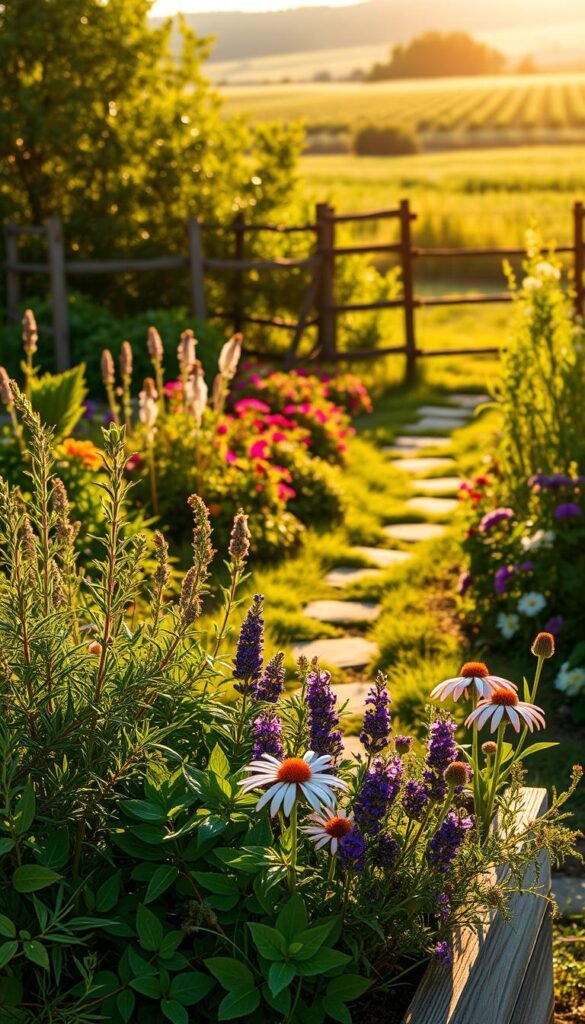Growing your own healing plants is easier than you think. Whether you’re new to gardening or looking to expand your skills, cultivating a vibrant collection of natural remedies offers countless rewards. Imagine stepping outside to snip fresh leaves for tea, salves, or tinctures—all grown right in your backyard or on a sunny windowsill.
Starting a herb garden doesn’t require fancy tools or acres of space. Many popular varieties, like lavender or chamomile, thrive with minimal care. You’ll save money over store-bought options while ensuring your remedies are free of additives. Plus, there’s something deeply satisfying about nurturing plants that support your well-being.
This guide simplifies the process, covering everything from choosing the right soil to drying your harvest. You’ll learn which species work best for small spaces, how to avoid pests naturally, and why timing matters when picking leaves. Even if you’ve never kept a houseplant alive, these strategies set you up for success.
By the end, you’ll have the confidence to grow a personalized medicinal herbs collection tailored to your needs. Let’s dig into the basics and unlock the power of nature’s pharmacy—one seedling at a time.
Starting Your Medicinal Herb Journey: Understanding the Basics
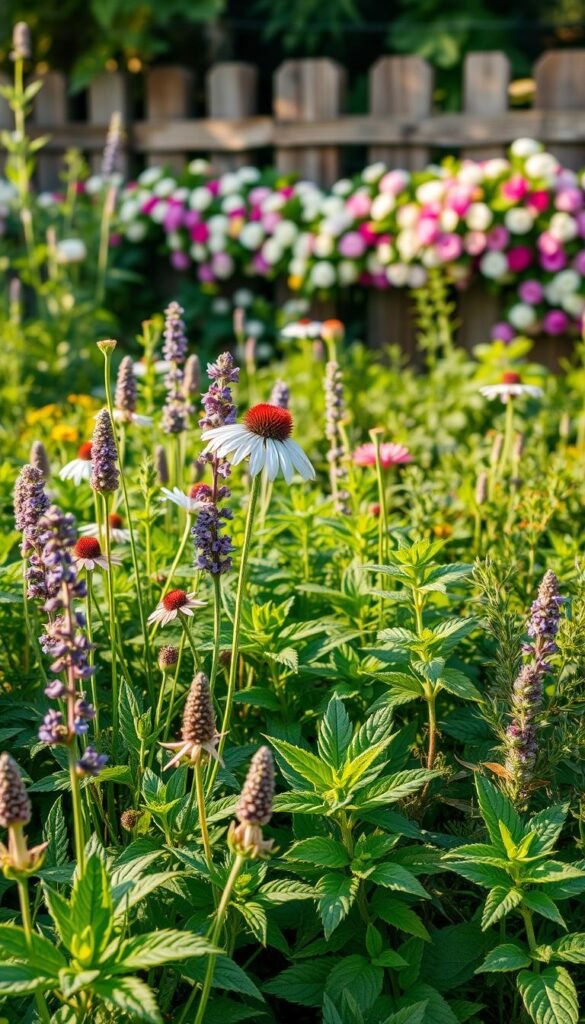
Harnessing nature’s power through homegrown botanicals offers surprising simplicity. You don’t need vast experience or expensive setups—just sunlight, water, and curiosity. Let’s explore why this practice has endured for centuries and how it fits modern lifestyles.
Why Grow Medicinal Herbs at Home?
Freshness beats store shelves every time. Commercial products lose potency during processing and storage. When you cultivate plants yourself, you preserve their active compounds at peak levels. This means stronger teas, tinctures, and salves for everyday needs.
Cost savings add up quickly. A $3 seed packet yields months of remedies—compare that to $10 bottles at health stores. You’ll also avoid unwanted additives like synthetic preservatives or pesticides.
The Benefits of an Herbal Garden
Tending plants does more than stock your medicine cabinet. Studies show gardening reduces stress hormones by 30%*. The rhythmic tasks of watering and pruning create mindful moments in hectic days.
Consider these advantages:
| Aspect | Homegrown | Store-Bought |
|---|---|---|
| Potency | Highest at harvest | Diminished over time |
| Cost | $0.10 per ounce | $2.50 per ounce |
| Control | Full customization | Limited options |
Your space limitations don’t matter. Many healing plants thrive in containers. Basil, thyme, and calendula adapt well to patio pots or windowsills. Start with 2-3 varieties and expand as confidence grows.
Essential Tools and Resources for Beginner Herb Gardeners
Equipping yourself properly makes cultivating healing plants simpler and more rewarding. Start with a few key items to ensure healthy growth and efficient care. Building relationships with trusted suppliers helps you avoid common pitfalls.
Must-Have Gardening Tools
Sharp pruning shears top the list for clean harvesting. A hand trowel helps transplant seedlings without root damage. Use a watering can with a fine rose attachment to mimic gentle rainfall.
| Essential Tools | Purpose | Optional Upgrades |
|---|---|---|
| Pruning shears | Precise harvesting | Ergonomic grips |
| Hand trowel | Soil work | Stainless steel models |
| Watering can | Moisture control | Self-watering pots |
Reliable Online and Local Resources
Local nurseries offer climate-specific advice. Ask staff about their growing methods and pesticide use. For seeds, try Baker Creek or High Mowing for organic varieties.
Your basic toolkit needs only 4-5 items to begin. Cooperative extension offices provide free soil testing guides. Online forums connect you with experienced growers for troubleshooting tips.
From Seed to Harvest: Medicinal Herbs Garden Tips for Beginners
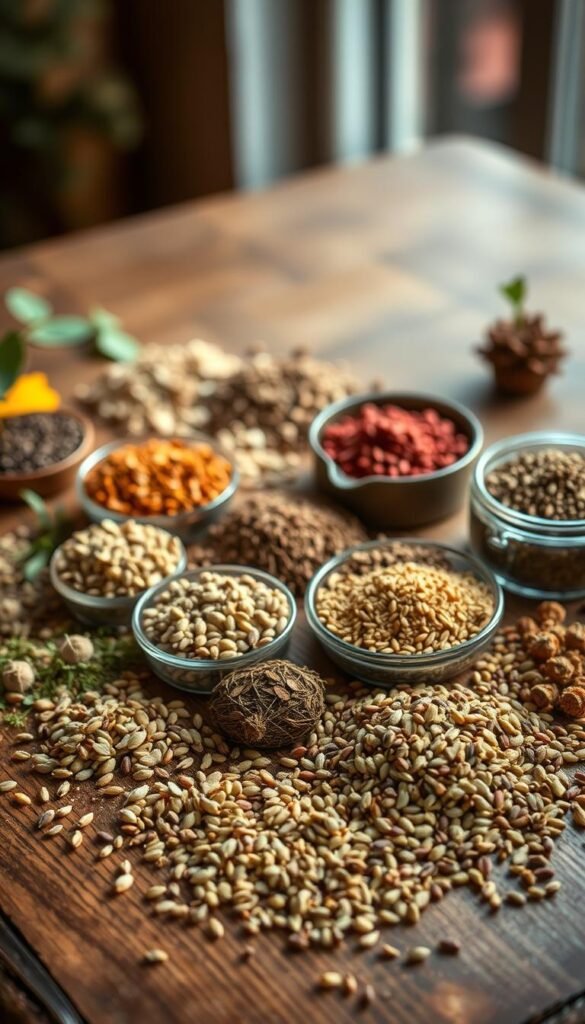
Getting your remedies growing begins with knowing which plants prefer seeds versus transplants. Some varieties flourish when sown directly, while others need a head start. This choice impacts your garden’s productivity and your wallet.
Direct seeding works best for fast growers like cilantro and basil. These plants develop strong roots without transplant shock. Dill and parsley also thrive when sown straight into soil—their taproots dislike disturbance.
| Best Direct-Sown | Transplant-Friendly | Special Cases |
|---|---|---|
| Cilantro | Rosemary | Mint (cuttings) |
| Basil | Lavender | Oregano (divisions) |
| Dill | Lemon Balm | Thyme (layering) |
One seed packet often yields enough plants for a family’s needs. Store leftovers in airtight containers—they’ll stay viable for 2-3 years. Time your planting using local frost dates; most seeds sprout best in 60-70°F soil.
For small spaces, try container gardening. Many medicinal varieties adapt well to pots. You’ll enjoy fresh leaves within weeks while slower-growing plants establish themselves.
Selecting and Planting the Right Medicinal Herbs
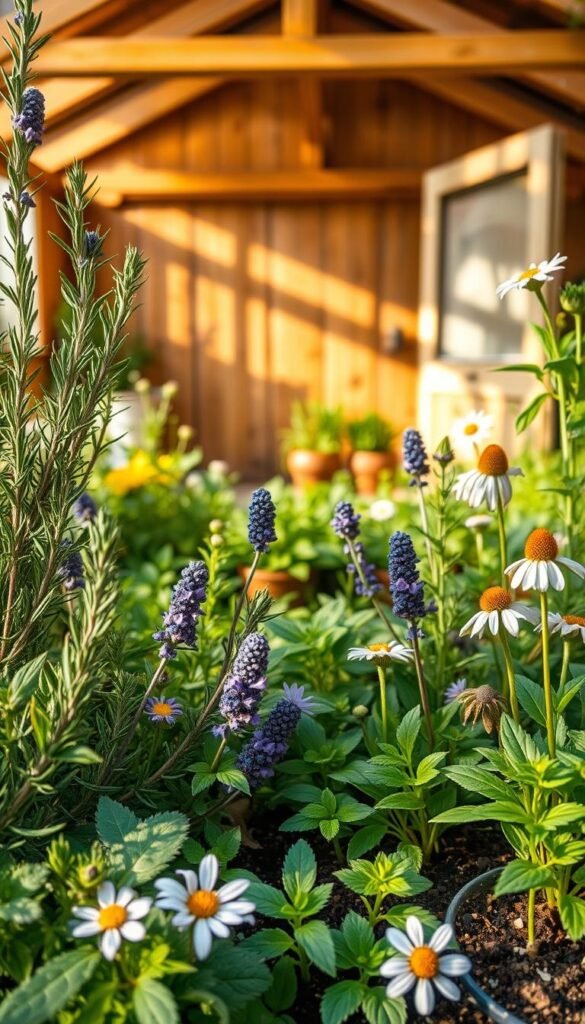
Your local climate determines which herbs will thrive. Match plants to your USDA zone for healthier growth and better yields. Start by checking your zone on the USDA website—it takes 30 seconds and saves months of frustration.
Climate-Smart Choices for New Growers
Five easy starters adapt to most regions. Calendula handles cool springs when sown after frost. Rosemary loves warm zones 7-11 but grows from cuttings better than seeds. Spilanthes needs tropical climates but thrives in pots up north if started indoors.
| Plant | Zones | Best Method |
|---|---|---|
| Holy Basil | 10-11 | Direct sow/indoor start |
| Spearmint | 3-7 | Root divisions |
| Calendula | All* | Direct sow |
Seed Strategies Simplified
Some plants hate moving. Sow cilantro and dill straight into garden beds. For slow starters like Spilanthes, use biodegradable pots to avoid root shock. Smart planning combines both methods—direct sow quick growers while nurturing tender seedlings indoors.
Mint family plants spread aggressively. Contain them in pots with drainage holes. Rosemary cuttings root easily in water—snip a 4″ stem and watch roots form in 2 weeks. Your healing garden grows best when you work with nature’s rules.
Optimizing Soil, Sunlight, and Watering Techniques
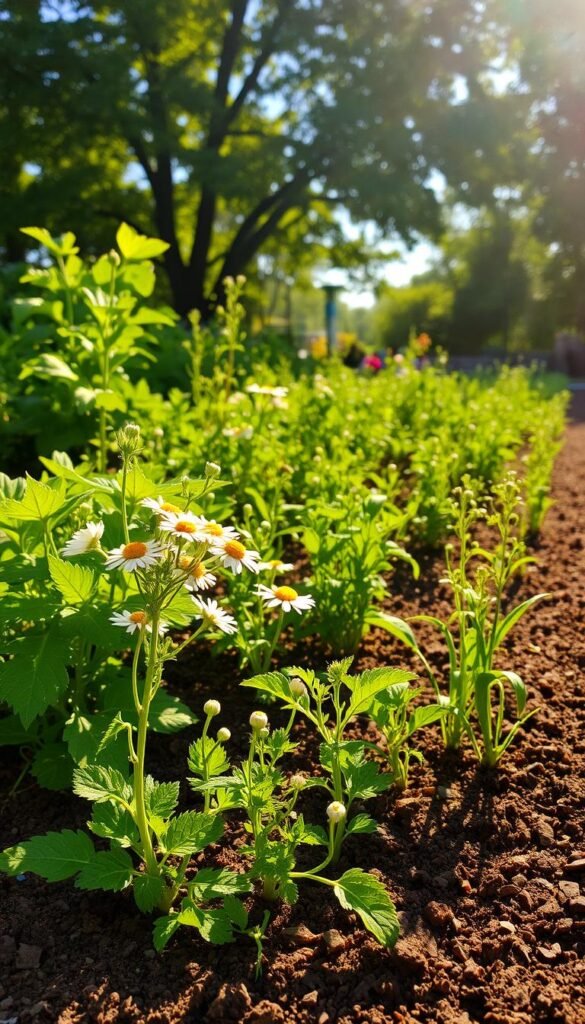
Creating the perfect environment for your healing plants starts with three key elements. Getting these right means stronger growth and more potent remedies. Let’s break down how to balance these factors for different species.
Preparing the Right Soil Mixture
Well-draining soil prevents root rot while keeping roots nourished. Mix 60% quality potting soil with 30% compost and 10% perlite. This combo works for most varieties except moisture-lovers like Spilanthes, which need extra organic matter.
| Plant | Soil Type | Sunlight | Water Needs |
|---|---|---|---|
| Calendula | Sandy loam | Full sun | Low |
| Rosemary | Gritty mix | Full sun | Minimal |
| Spearmint | Moist compost | Partial shade | High |
Container vs. Ground Planting Strategies
Pots let you control conditions tightly—ideal for aggressive spreaders. Try no-fail container herbs like Tulsi. Ground planting suits deep-rooted plants if you amend heavy soils with sand.
Group herbs with similar needs. Full-sun lovers like Rosemary thrive together. Keep Spearmint separate in its own pot to avoid takeover. Check soil moisture daily—stick your finger 1″ deep to test.
Seasonal Strategies: Planting, Pruning, and Winter Herb Care
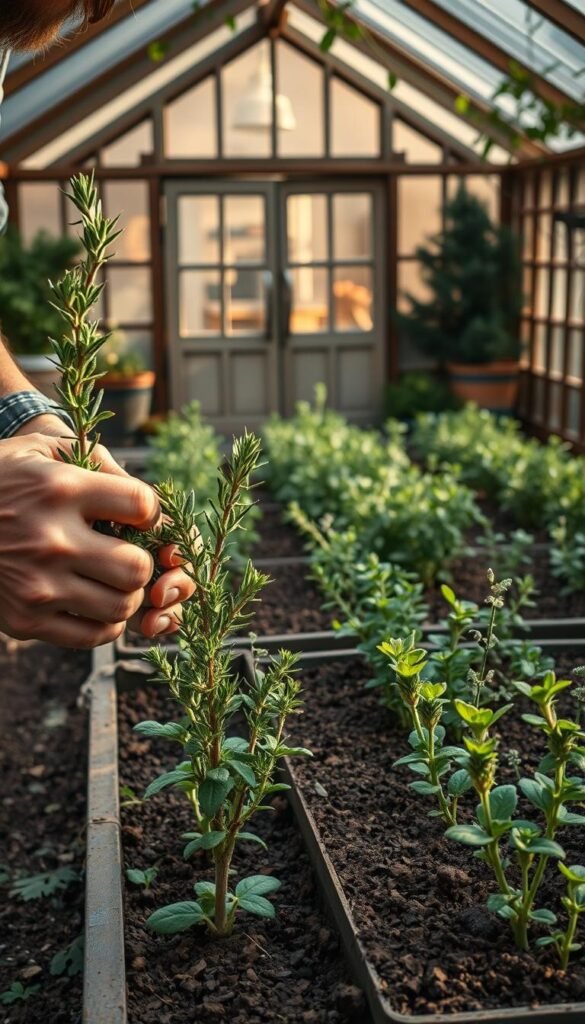
Mastering seasonal rhythms keeps your herbal allies thriving year after year. Timing your tasks ensures robust growth and maximizes harvests. Let’s explore how to work with nature’s calendar rather than against it.
Adapting to Seasonal Changes
Prune smarter, not harder. Mint-family plants like lemon balm bounce back stronger when trimmed by one-third each season. This encourages bushier growth and prevents legginess. For woody varieties like rosemary, snip only the green stems—cutting into old wood stunts recovery.
Spring demands action. Once frost risks pass, cut perennial stems to ground level. This clears space for fresh shoots. Divide overgrown clumps every 3 years to maintain vigor.
Tips for Protecting Your Herbs in Winter
Shield roots before first frost. Apply 3″ of straw or shredded leaves around base stems. Tender plants like ginger thrive indoors near sunny windows. For hardy types, try winter gardening strategies used for cold-tolerant crops.
- Collect seeds from spent flowers in late fall
- Move potted sage or thyme to sheltered areas
- Stop fertilizing 6 weeks before expected freezes
With these steps, your green companions will greet spring ready to flourish. Seasonal care builds resilience, letting you enjoy nature’s remedies for decades.
Mastering Harvesting Techniques for Medicinal Herbs
Knowing when and how to gather your herbs makes all the difference in their healing power. The right approach preserves their active compounds while encouraging future growth. Let’s explore how to maximize your efforts with simple, effective strategies.
Identifying the Right Harvest Time
Timing varies by plant part used. Calendula’s bright flowers hold the most benefits when picked at peak bloom. For basil, snip leaves in the morning after dew dries—this locks in flavor and medicinal oils. Rosemary stems are best harvested just before flowering for concentrated potency.
Watch for visual cues. Mint’s leaves darken slightly when oils peak. With thyme, trim lightly during midday sun to avoid moisture buildup. Regular cutting keeps plants bushy and productive.
Harvesting Methods to Preserve Medicinal Properties
Use clean, sharp scissors to avoid crushing stems. For rosemary and other woody herbs, cut just above leaf nodes to promote regrowth. Handle delicate leaves like Tulsi gently to prevent bruising—air-dry them in shaded areas.
Involve your family by growing herbs indoors for year-round access. Teach kids to harvest mint 1″ above soil level. Proper techniques ensure every clipping supports wellness and garden vitality.

